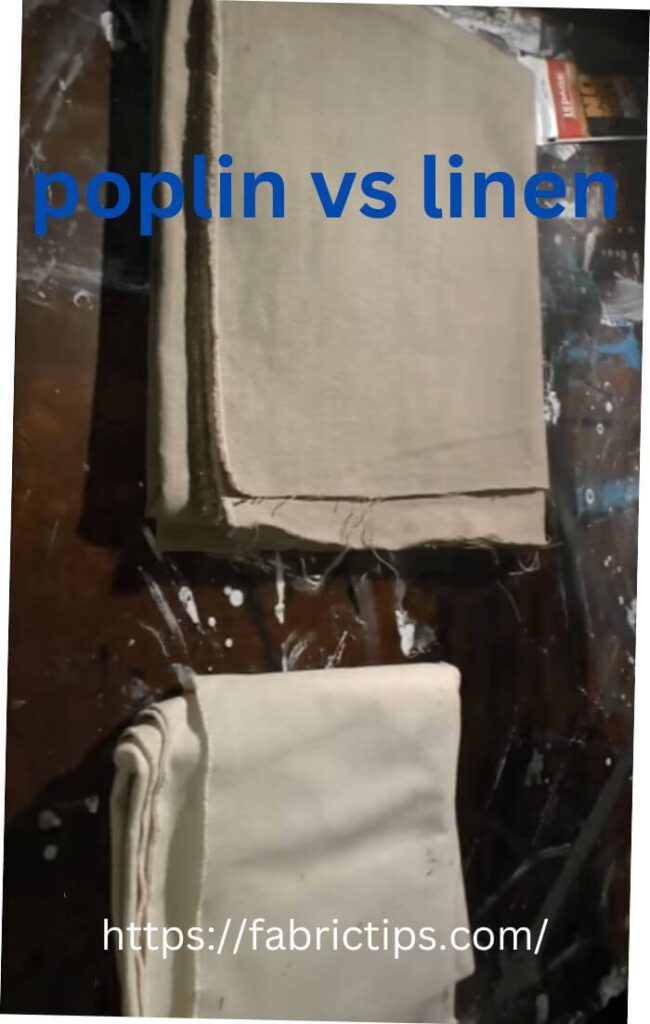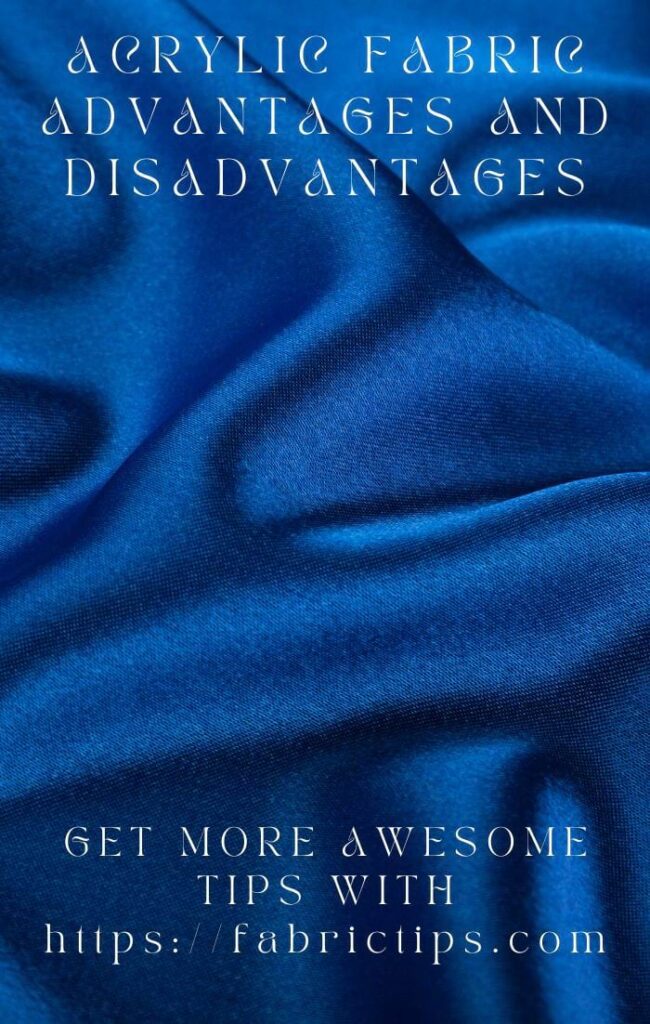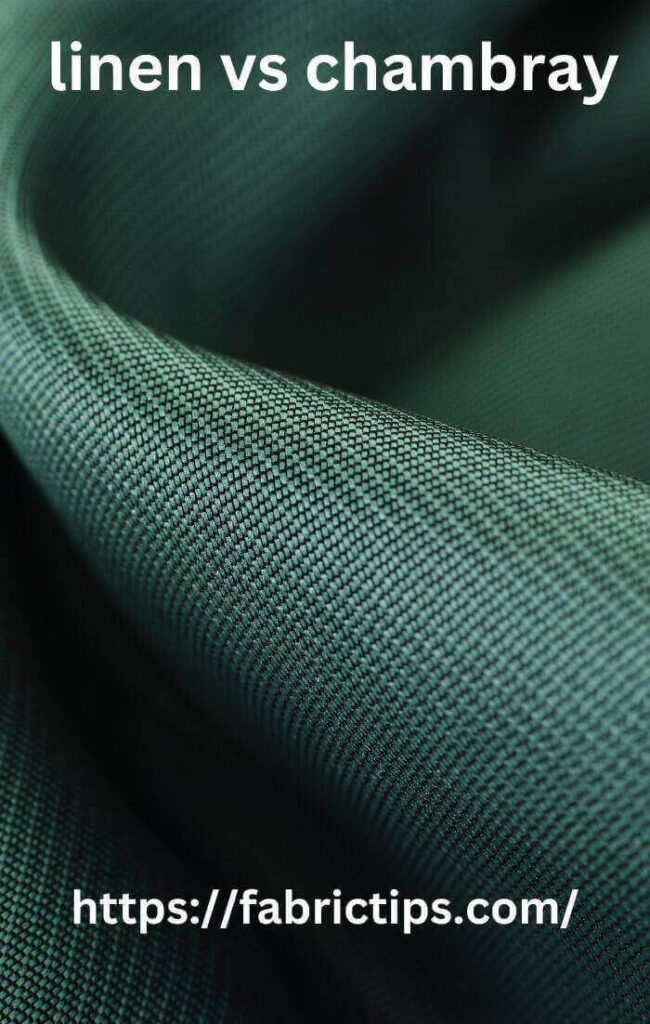Last Updated on December 13, 2025 by Wahid
Poplin:– “Poplin” a plain weave fabric that is especially suitable for suits, uniforms, choir robes and can also be used as a tablecloth. The fabric can be washed endlessly.
Linen:– “Synthetic linen,” similar to linen from flax plants, can be used for clothing such as suits, dresses, and sportswear. It can be washed endlessly, never losing its natural luster or body.
Poplin Vs Linen: how do they differ? What should you pick? Basically, both fabrics are made of natural fibers and are durable, breathable, & soft. What are the actually differences between them? Read on to discover below.
Poplin Fabric: What Is It?

- Poplin was first made in the 15th century, and it got its name from its feel.
- Featuring fine ribs and a canvas-type weave, this fabric is extremely lightweight, breathable, and perfect for trousers, tops, and light jackets.
- Original poplin fabrics were made of wool and silk, giving them a similar feel & texture to broadcloth.
- Fabrics made from poplin are woven, just like linen.
- Whether natural or synthetic, poplin can be made from a wide variety of fibers. There are times when it even consists of variety of fiber.
Advantages Of Using “Poplin Fabric”
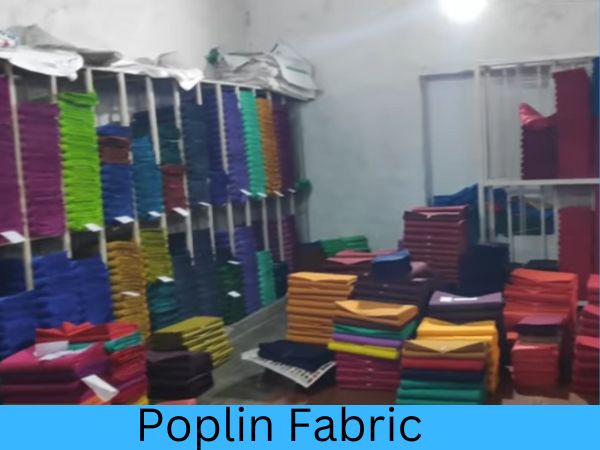
In addition to its low maintenance, poplin fabric offers a variety of advantages. Dry cleaning or ironing aren’t necessary with this fabric, unlike cotton.
- Despite its natural wrinkle resistance, it is very easy to make straight. Due to its convenience, it is ideal for people who are on the go.
- Moreover, when washed, poplin fabric does not release odors, nor does it stain easily.
- Because poplin is such an easy & versatile fabric, it is suitable for a variety of garments, from any “dresses to jeans.”
- In formal as well as informal settings, its subtle sheen makes it a versatile choice.
- Every type of wardrobe can benefit from its versatility.
- The dye can be applied easily and it maintains its color with repeated application.
- There are many advantages to poplin fabric, including its longevity, ease of maintenance, and wrinkle-resistant properties.
- In poplin, cotton is used, while other fibers, like silk threads, are also made of cotton. Cotton-poly blends are also possible.
- The fabric should be machine-washed on cold and warm settings, but it must not be overheated.
- Turkey, China, and India manufacture some, but the most are affordable. In some cases, they are inexpensive, while in others, they are expensive. Poplin fabric is not only affordable but also a high quality fabric.
Disadvantage Of Using “Poplin Fabric”
- The poplin fabric is a cotton type that is made from warp fibers of worsted yarn & filling yarns of cotton.
- Since then, poplin fabric’s definition has expanded, although single-fiber versions have no cords. Consequently, poplin is also known as tabinet.
- Despite its tight and plain weave, it has a less complex weave than satin or twill cotton.
- The choice of poplin material should be made carefully. It should be made from high-quality cotton, since the wrong washing method can make it very hot.
Linen Fabric: What Is It?
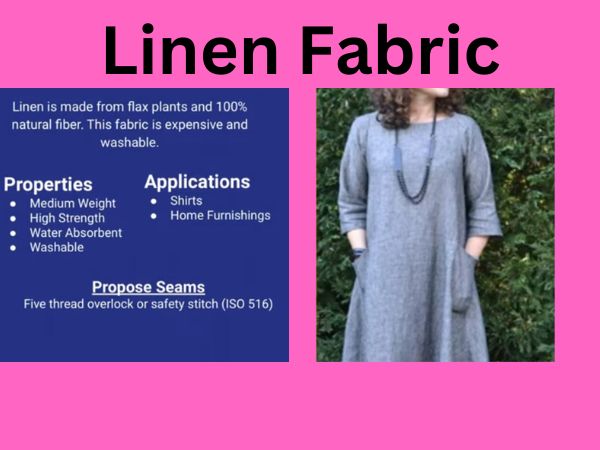
- Ancient Egypt, 4000 years ago, was thought to have used linen as clothing. All-natural linen is produced by flax stalks.
- However, during the Victorian era, Belfast emerged as the world’s linen capital.
- The linen fabric is commonly used for napkins, towels, tablecloths, and bed sheets.
- As a natural fiber, linen is similar to cotton, though flax fibers are difficult to weave and take longer to harvest.
- An extremely strong and lightweight fabric, belonging to the Linum genus of the Linaceae family.
- Even though they are not always made of linen fabric, linens are still referred to as household items.
Advantages Of Using “Linen Fabric”
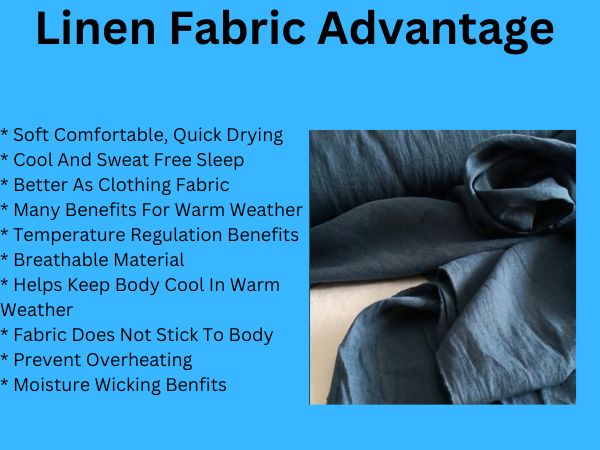
- When linen is 20% by own weight, the absorbed water can be released quickly. You cannot stay dry no matter how much sweat you produce.
- Keeping the electrolyte balance of the body is made easier with linen clothing.
- Wearing linen clothing causes the body to sweat 1.5 times less in comparison to using cotton clothing.
- According to Japanese research, clothing fabrics with 20% linen can reduce radiation by 80%.
- Static electricity can be prevented by incorporating only 10% flax into blended fabrics.
- The use of cotton & linen can provide relief from restlessness, headaches, chest tightness, and difficulties breathing.
- Due to linen’s ability to inhibit fungi, and bacteria, some diseases can be prevented by wearing linen and cotton for long periods of time.
- As a result of linen sheets, bedsores can be prevented for bedridden patients, while linen clothing is beneficial in the prevention and treatment of certain skin conditions, such as ordinary rashes & chronic eczema.
- In fact, linen clothing can be a boon to people who suffer from allergies.
- However, linen fabric does not only prevent allergic reactions, it can also help treat allergies.
- Fever and inflammation can be reduced with linen.
Disadvantages Of Using “Linen Fabric”
- Linen fabric wrinkles very easily.
- However, linen clothing is becoming more common without being ironed or obsessively maintained.
- Upon bleaching or dyeing, linen fabric loses their biodegradable properties. The untreated nature of linen makes it more sustainable.
- It’s true flax plants don’t need them, but some companies will use them for speeding up the process.
Cost Of “Linen Fabric”
In terms of cost, linen varies greatly depending on its quality and weave density. According to the 2010 price list, rougher linen can cost approximately $12.98 per yard, which is lower than finer linen. Clothing and household linens of this type are commonly apply for everyday use. The cost of a finer woven linen that is smoother, lighter, and has a greater sheen is $99 per yard. Household heirlooms, baptismal gowns, & high-end clothing are typically made from this type of linen.
FAQs
01. Why Is Linen Better Than Cotton?
In addition to being highly breathable, linen is also highly absorbent. Therefore, you stay cool for longer, as any moisture you produce is quickly evaporated. As a result, linen is perfect for offices and summer with no air conditioning.
Besides being 30% stronger when compared to cotton, linen also lasts longer. When new, cotton shirts are silky and smooth. However, over time, they lose their soft touch over time, while linen shirts get better as they age.
02. How Do I Print On Poplin Fabric?
There has never been an easier way to print poplin fabric. Add your design, photo, or pattern, or whatever else you like by dragging and dropping it into our design interface. Even if you want to reduce or increase the dimensions, you can use our online design tool. Order a test print to see how easy work on it, plus get a discount the first time you order fabric.
03. What Is The Difference Between Cotton And Poplin?
A 100% cotton poplin fabric has a poplin weave and is made entirely from cotton. In poplin, warps and wefts are made from a variety of thicknesses of thread. In cotton-only fabrics, poplin has the same thickness across both grains & loses its ribbed appearance.
04. Is Poplin A Linen?
This plain weave fabric is durable and is especially useful for suits, uniforms, choir robes and tablecloths. This fabric is easily launder-able. However, linen – generally synthetic linen, derived from flax plants, is used in sportswear, suits, and dresses.
05. Does Poplin Wrinkle Easily?
No. You can iron it without any problems and it doesn’t wrinkle easily. So, busy men & women looking their best no matter what occasions they attend will find this product perfect. You should use it when you’re making shirts because it’s relaxing to wear & looks well all day.
06. Is Linen A Luxurious Fabric?
Over 8,000 years have passed since linen was first used to weave fabrics. Since then, these textiles have evolved from common materials to luxurious, acclaimed fabric, manual processes, and labor-intensive process of yarn production.
07. Is Poplin Good For A Dress Shirt?
The poplin fabric is a great choice for warm weather dress shirts. Due to its dye ability and bleach ability, it is a popular material for printed and patterned clothing. Despite being lightweight, it keeps the wearer looking polished and professional throughout a warm day.
08. Is Linen Cheap Or Expensive?
Considering linen’s incredible and unique properties, such as its extreme moisture absorption, linen is usually a more expensive fabric. No matter what you need, whether you need linen clothes, bed sheets, or linen towels. It is much more comfortable to sleep on bed sheets that can absorb moisture.
09. Is Linen Or Silk Better?
Despite each fabric’s breath ability, linen is the best moisture absorber compared to cotton & silk. The production of linen requires fewer resources, contributing to its eco friendliness and sustainability.
10. When Should You Not Wear Linen?
In traditional thinking, linen clothing should not be worn before Memorial Day or after Labor Day. In Southern California, it’s not unusual to not wear it year-round, despite the fact that most people adhere to this rule. Hence, enjoy the natural feel of linen and enjoy your “summer” linens.
11. Why Is Linen The Best Material?
There has never been a more biodegradable & stylish fabric in the history of fashion than linen. Due to its strength, moth resistance, and flax plant fibers, it is fully biodegradable when untreated (i.e. not colored). There are 4 natural colors of this wood: ivory, tan, ecru, and grey.
The Final Word
In examining Poplin Vs Linen, each material has different attributes, such as breath ability and absorbency. Poplin textiles and Linen textiles are both eco friendly because of their natural fibers.
However, poplin and linen clothes differ in many ways that render them distinctive. In poplin, the crosswise ribs are closely spaced, very fine, and the warp yarns are various weights and colors. Linen is useful in garments and comfortable in hot weather, due to its exceptional properties.
In the end, the last decision is yours to make, depending on your personal preferences, the weather, the quality, and your budget as well.
